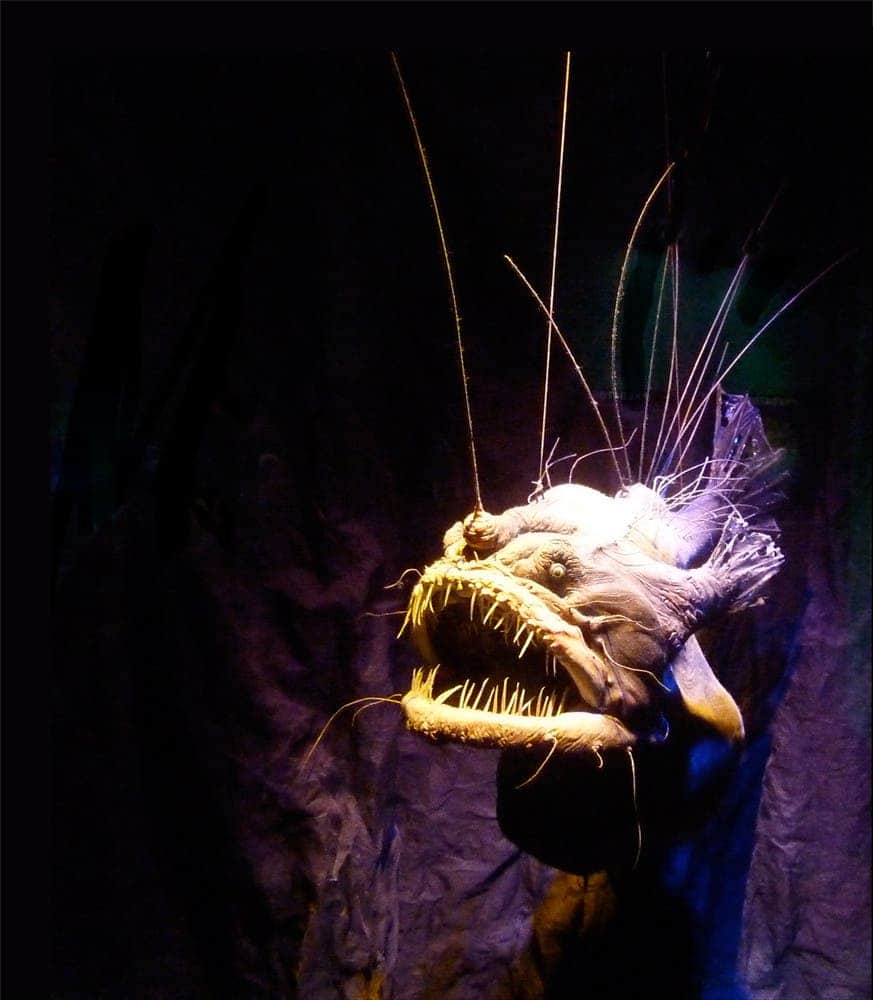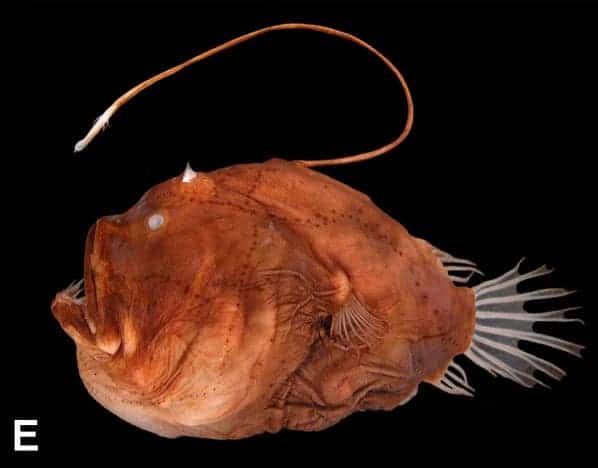
On the seafloor, thousands of feet below the water’s surface, lie some of the world’s most extreme and weird-looking creatures. It’s so cold and pitch dark that no plants can live there and the sheer weight of the water exceeds anything the human body can handle. Food is almost non-existent. Only darkness abounds, a crushing void. It’s no wonder then that the few creatures that call the deep sea their home simply look out of this world. The anglerfish is no exception.
The anglerfish is as fascinating as it is nightmarish-looking. Found mostly in the murky depths of the Atlantic and Antarctic oceans, they’re easily recognizable due to their huge heads, menacing crescent moon-shaped mouths laced with sharp translucent teeth, and the signature bioluminescent lure that protrudes above their mouths like a fishing pole, hence the name. However, the lure is sported only by the female. Males are far less menacing-looking and their expendable sex lives are dubious, to say the least — but we’ll get to that in a minute.
The first deep-sea anglerfish were documented in the early 19th-century, when an almost spherical fish washed ashore in Greenland. Zoologist Johannes Cristopher Reinhardt dissected this most peculiar fish in his lab in Copenhagen, which he called the footballfish (Himantolophus groenlandicus). Over time, some sailors would find other such creatures trapped in their nets from time to time — a sight so bizarre it exceeds even the most embellished fisherman stories. Luckily, cameras had just been invented and the anglerfish was ready to rise from its mythical depths and stir our imagination. But, while common folk contorted their faces in revulsion, marine scientists were hungry to learn more.
Today, scientists know of more than 170 species divided into 18 families of deep-sea anglerfish, part of the suborder Ceratioidei — the least known, for obvious reasons, of the five primary lineages of the order Lophiiformes. The diversity of species and morphology is huge as many species have adapted to the specific conditions found at a range of depths, from 300 to 5,000 meters (1,000 to 16,500 feet) below the water’s surface where food availability can vary wildly.
Some are squat and oval like Melanocetus johnsonii, others are flat with a protruding snout like Thaumatichthys binghami. Some have longer glowing lures than others, while one particular anglerfish off the West African coast has its glowing bait conveniently located inside its giant mouth. Their common names also vary wildly, depending on the type of anglerfish. The snaggletooth sea devil, blacksea devil, wolf trap, or the tyrannical toad are all different names celebrating the, uhm, unique appearance of this fish.
Most aren’t larger than a closed fist, though the largest known anglerfish, most notably Certias species, can grow up to 1.2 meters (4 feet) in length.

Gruesome with a purpose
Despite its unflattering appearance, the anglerfish couldn’t care less. Fish that swim in shallower water have streamlined, hydrodynamic bodies designed for speed – which, incidentally, are also aesthetically pleasing to humans. But the anglerfish is built differently.
Anglerfish live deep in the sea, where there is little food, especially for a predator. In order to adapt, the anglerfish has traded speed for a low-energy metabolism, making minimal movements until its ambush is perfectly set up. It also developed a huge, oversized mouth and specialized intestines because feeding opportunities are so rare. Consuming large prey could keep it happily floating on the bottom of the sea for months.
Everything about the anglerfish, from its blobby, spherical body to its huge teeth, is perfectly designed for the unforgiving life in the dark, chilly depths of the sea. If the end result looks like a monster to you or me, the anglerfish couldn’t care less. It’s too busy surviving.
The fish that fishes other fish
Anglerfish sport a radically different design from other fish, with their first dorsal-fin spine mounted on the snout and modified to serve as a luring apparatus. In the darkness of the ocean floor, the bioluminescent light radiated by the lure must be irresistible. Depending on the species, the rod flashes in yellow, yellow-green, blue-green, or orange-purple.

The source of the light emitted by the bulbous appendage is symbiotic bioluminescent bacteria. The fish’s lure offers the bacteria shelter, while the bacteria provide the light — a win-win partnership known as mutualism.
Just like a fisherman will patiently sit by his pole for hours waiting for prey to hook, so does the anglerfish wiggle its lure in search of fish — no bait needed though. Once prey is within striking range, the carnivorous female anglerfish will snag it using her large, pointy teeth.
Besides the emblematic bright rod, at least some anglerfish also have long filaments reaching outward from the female’s body. According to marine biologists at the University of Washington, these filaments have nerves and likely act as sensors alerting the angler of nearby movements in the water, not all that different from the role served by a cat’s whiskers or an insect’s antennae.
This rare but extraordinary video below showcases these sensory antennae in all their splendor. However, scientists are still not sure whether these antennae are self-illuminating or they are simply reflecting the lights from the submersible that captured the footage in the waters of Portugal’s Azores islands.
“Any prey item touching one of those would cause the angler to turn and gobble up that particular animal,” Ted Pietsch, a deep-sea fish researcher at the University of Washington in Seattle, told Science. “They can’t afford to let a meal go by because there’s so little to eat down there.”
Dissections of anglerfish stomachs showed that the animals eat shrimp-like deep-sea creatures, squids, worms, and even lanternfish which are one of the few fish capable of seeing at these depths thanks to the blue-green lights embedded all over their bodies and their large eyes.
Once prey is detected, it is immediately gobbled up in the anglerfish’s huge mouth, which is pliable enough to accommodate swallowing prey up to twice the size of the fish. Prey is partially sliced up by this predator’s large teeth, but also, once prey is caught, the mouth stays shut – the angler’s teeth now trapping its prey like an iron cage. Smaller teeth that line the floor of the mouth and throat finish the prey off and cut it up further for digestion inside the belly of the deep sea beast.
A gruesome love affair with a parasitic boyfriend

The video above with the shining rays is extraordinary for another reason: it’s the very first footage showing a female and male anglerfish pairing, one of the weirdest unions in the world.
Sexual dimorphism, the differences in appearance between males and females of the same species, is as extreme as it gets in anglerfish.
Compared to a female, a male anglerfish can be up to 60 times smaller in length and about half a million times lighter. From birth, males’ only mission in life is to find a female with whom to mate. They have nothing else on their minds, not even food. Indeed, the male anglerfish has no way of procuring food on its own, in the first place.
The males’ bodies also look radically different — they’re not just miniature versions of the female. They’re much more slender and muscular, allowing them to swim long distances in their desperate, life-or-death quest for a mate. They lack the glowing appendage, but they’re still hunters — hunters of love. Assisting them in this quest are their relatively large olfactory organs, which they probably use to follow a trail of pheromones leading to a female.
Once they finally find a female, the male gives the female a love bite, latching on to her for virtually the remainder of his days.
This isn’t the most healthy relationship though. This clingy boyfriend is now a parasite. While I know some female readers might have used this epithet before to characterize a former lover, I’m using the term literally.
Once attached to the female, the male depends on her for survival, receiving nutrients through the blood flow from the female. The fact that the anglerfish is the only animal in the world in which members of the opposite sex attach permanently and exchange fluid isn’t the oddest thing though.
The skin tissue of the male actually fuses with that of the female, so they end up looking like a wart on the side of the female. Over time, the male loses his eyes and all of his internal organs — all except the testicles. In effect, the fusion reduces the male to a sack of sperm which the female uses to fertilize her eggs. A female is able to carry six or even more males at a time on her body.
Just the tip of the iceberg
For the nearly two centuries since scientists have been aware of the anglerfish’s existence, we’ve had to rely on dead specimens washed ashore on some cold beach or trapped by accident in the nets of fishermen. But more recently, marine biologists have started to widely use autonomous and robotic submersibles capable of exploring the ocean depths to unprecedented limits.
In doing so, we’re now starting to study live anglerfish, and other extraordinary deep-sea creatures, in incredible detail, in their habitat. This means we can now actually see how the anglerfish actually behaves in the wild, not just what’s inside its guts.
As our spacecraft and rover explore Mars and beyond Jupiter’s icy moons, many scientists respectfully remind us that we shouldn’t ignore the deep sea, which in many ways is less understood than alien planets. By getting to know the anglerfish, we might be getting as close to an alien being as we ever will.


